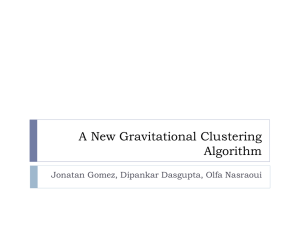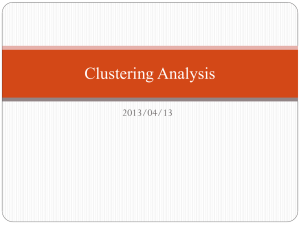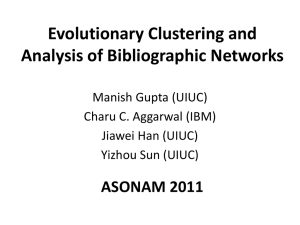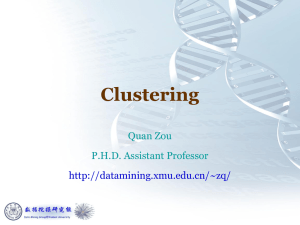CS 498 Probability & Staticstic
advertisement
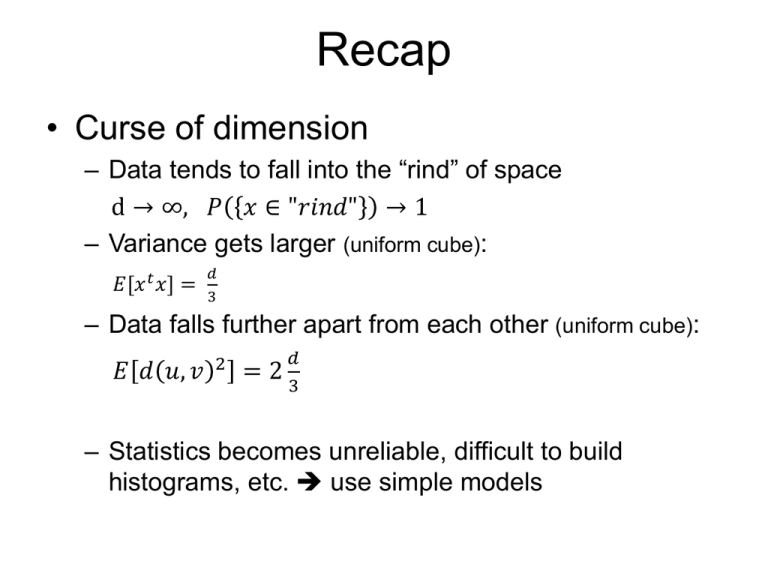
Recap
• Curse of dimension
– Data tends to fall into the “rind” of space
d → ∞, 𝑃 𝑥 ∈ "𝑟𝑖𝑛𝑑" → 1
– Variance gets larger (uniform cube):
𝐸[𝑥 𝑡 𝑥] =
𝑑
3
– Data falls further apart from each other (uniform cube):
𝐸 𝑑 𝑢, 𝑣
2
=2
𝑑
3
– Statistics becomes unreliable, difficult to build
histograms, etc. use simple models
Recap
• Multivariate Gaussian
– By translation and rotation, it turns into multiplication
of normal distributions
– MLE of mean: 𝜇 =
Σ𝑖 𝑥𝑖
𝑁
– MLE of covariance: Σ =
Σ𝑖 (𝑥𝑖 −𝜇) 𝑥𝑖 −𝜇 𝑇
𝑁
Be cautious..
Data may not be in one blob, need to separate data into groups
Clustering
CS 498 Probability & Statistics
Clustering methods
Zicheng Liao
What is clustering?
• “Grouping”
– A fundamental part in signal processing
• “Unsupervised classification”
• Assign the same label to data points
that are close to each other
Why?
We live in a universe full of clusters
Two (types of) clustering methods
• Agglomerative/Divisive clustering
• K-means
Agglomerative/Divisive clustering
Agglomerative
clustering
Divisive clustering
Hierarchical
cluster tree
(Bottom up)
(Top down)
Algorithm
Agglomerative clustering: an example
• “merge clusters bottom up to form a hierarchical cluster tree”
Animation from Georg Berber
www.mit.edu/~georg/papers/lecture6.ppt
Distance
Dendrogram
𝒅(𝟏, 𝟐)
>> X = rand(6, 2);
%create 6 points on a plane
>> Z = linkage(X);
%Z encodes a tree of hierarchical clusters
>> dendrogram(Z); %visualize Z as a dendrograph
Distance measure
• Popular choices: Euclidean, hamming, correlation, cosine,…
• A metric
–
–
–
–
𝑑
𝑑
𝑑
𝑑
𝑥, 𝑦
𝑥, 𝑦
𝑥, 𝑦
𝑥, 𝑦
≥0
= 0 𝑖𝑓𝑓 𝑥 = 𝑦
= 𝑑(𝑦, 𝑥)
≤ 𝑑 𝑥, 𝑧 + 𝑑(𝑧, 𝑦) (triangle inequality)
• Critical to clustering performance
• No single answer, depends on the data and the goal
• Data whitening when we know little about the data
Inter-cluster distance
• Treat each data point as a single cluster
• Only need to define inter-cluster distance
– Distance between one set of points and another set of
points
• 3 popular inter-cluster distances
– Single-link
– Complete-link
– Averaged-link
Single-link
• Minimum of all pairwise distances between
points from two clusters
• Tend to produce long, loose clusters
Complete-link
• Maximum of all pairwise distances between
points from two clusters
• Tend to produce tight clusters
Averaged-link
• Average of all pairwise distances between
points from two clusters
𝐷 𝐶1 , 𝐶2
1
=
𝑁
𝑑(𝑝𝑖 , 𝑝𝑗 )
𝑝𝑖 ∈𝐶1 ,𝑝2 ∈𝐶2
How many clusters are there?
Distance
• Intrinsically hard to know
• The dendrogram gives insights to it
• Choose a threshold to split the dendrogram into clusters
𝒕𝒉𝒓𝒆𝒔𝒉𝒐𝒍𝒅
An example
do_agglomerative.m
Divisive clustering
• “recursively split a cluster into smaller clusters”
• It’s hard to choose where to split: combinatorial problem
• Can be easier when data has a special structure (pixel grid)
K-means
• Partition data into clusters such that:
– Clusters are tight (distance to cluster center is small)
– Every data point is closer to its own cluster center than to all
other cluster centers (Voronoi diagram)
[figures excerpted from Wikipedia]
Formulation
• Find K clusters that minimize:
Cluster center
Φ 𝑪, 𝒙 =
𝒙𝒋 − 𝝁𝑖 )
𝑇
𝒙𝑗 − 𝝁𝑖
𝑖∈||𝑪|| 𝒙𝑗 ∈𝑪𝑖
• Two parameters: {𝑙𝑎𝑏𝑒𝑙, 𝑐𝑙𝑢𝑠𝑡𝑒𝑟 𝑐𝑒𝑛𝑡𝑒𝑟}
• NP-hard for global optimal solution
• Iterative procedure (local minimum)
K-means algorithm
1. Choose cluster number K
2. Initialize cluster center 𝜇1 , … 𝜇𝑘
a. Randomly select K data points as cluster centers
b. Randomly assign data to clusters, compute the cluster center
3. Iterate:
a. Assign each point to the closest cluster center
b. Update cluster centers (take the mean of data in each cluster)
4. Stop when the assignment doesn’t change
Illustration
Randomly initialize 3
Assign each point to the
Update cluster center
cluster centers (circles) closest cluster center
[figures excerpted from Wikipedia]
Re-iterate step2
Example
do_Kmeans.m
(show step-by-step updates and effects of cluster number)
Discussion
• How to choose cluster number 𝐾?
– No exact answer, guess from data (with visualization)
– Define a cluster quality measure 𝑄(𝐾) then optimize 𝐾
K = 2?
K = 3?
K = 5?
Discussion
• Converge to local minimum => counterintuitive clustering
[figures excerpted from Wikipedia]
Discussion
• Favors spherical clusters;
• Poor results for long/loose/stretched clusters
Input data(color indicates true labels)
K-means results
Discussion
• Cost is guaranteed to decrease in every step
– Assign a point to the closest cluster center minimizes the
cost for current cluster center configuration
– Choose the mean of each cluster as new cluster center
minimizes the squared distance for current clustering
configuration
• Finish in polynomial time
Summary
• Clustering as grouping “similar” data together
• A world full of clusters/patterns
• Two algorithms
– Agglomerative/divisive clustering: hierarchical clustering tree
– K-means: vector quantization
CS 498 Probability & Statistics
Regression
Zicheng Liao
Example-I
• Predict stock price
Stock price
t+1
time
Example-II
• Fill in missing pixels in an image: inpainting
Example-III
• Discover relationship in data
Amount of hormones by devices
from 3 production lots
Time in service for devices
from 3 production lots
Example-III
• Discovery relationship in data
Linear regression
• Input:
{ 𝒙1 , 𝑦1 , 𝒙2 , 𝑦2 , … 𝒙𝑀 , 𝑦𝑀 }
𝑦: ℎ𝑜𝑢𝑠𝑒 𝑝𝑟𝑖𝑐𝑒
𝒙: {𝑠𝑖𝑧𝑒, 𝑎𝑔𝑒 𝑜𝑓 ℎ𝑜𝑢𝑠𝑒, #𝑏𝑒𝑑𝑟𝑜𝑜𝑚, #𝑏𝑎𝑡ℎ𝑟𝑜𝑜𝑚, 𝑦𝑎𝑟𝑑}
• Linear model with Gaussian noise
𝑦 = 𝒙𝑇 𝛽 + 𝜉
–
–
–
–
𝒙𝑻 = 𝑥1 , 𝑥2 , … 𝑥𝑁 , 1
𝑥: explanatory variable
𝑦: dependent variable
𝛽: parameter of linear model
𝜉: zero mean Gaussian random variable
Parameter estimation
• MLE of linear model with Gaussian noise
𝑃
𝑚𝑎𝑥𝑖𝑚𝑖𝑧𝑒:
𝑀
=
𝑀
𝒙𝑖 , 𝑦𝑖
𝛽
Likelihood function
𝑇
𝑔(𝑦𝑖 − 𝒙𝑖 𝛽; 0, 𝜎)
𝑖=1
1
=
exp{−
𝑐𝑜𝑛𝑠𝑡
𝑀
𝑖=1
𝑀
𝑦𝑖 − 𝑥𝑖
𝑚𝑖𝑛𝑖𝑚𝑖𝑧𝑒:
𝑇
𝑦𝑖 − 𝒙𝑖 𝛽
2𝜎
𝑇
𝛽
2
}
2
𝑖=1
[Least squares, Carl F. Gauss, 1809]
Parameter estimation
• Closed form solution
Cost function
𝑀
Φ 𝛽 =
𝑇
𝑦𝑖 − 𝒙𝑖 𝛽
2
= 𝒚 − 𝑿𝛽 𝑇 (𝒚 − 𝑿𝛽)
𝑖=1
𝜕Φ(𝛽)
= 𝑿𝑇 𝑿𝛽 − 𝑿𝑇 𝒚
𝜕𝛽
𝑿𝑇 𝑿𝛽 − 𝑿𝑇 𝒚 = 𝟎
𝛽 = 𝑿𝑇 𝑿
𝒙𝟏
𝑿=
𝒙𝟐
…
𝒙𝑴
𝑇
𝑇
𝑇
Normal equation
−1 𝑿𝑇 𝒚
(expensive to compute the matrix inverse for high dimension)
𝑦1
𝒚 = 𝑦…2
𝑦𝑀
Gradient descent
•
http://openclassroom.stanford.edu/MainFolder/VideoPage.php?course=MachineLearning&vi
deo=02.5-LinearRegressionI-GradientDescentForLinearRegression&speed=100 (Andrew Ng)
𝜕Φ(𝛽)
= 𝑿𝑇 𝑿𝛽 − 𝑿𝑇 𝒚
𝜕𝛽
Init: 𝛽 (0) = (0,0, … 0)
Repeat:
𝛽 (𝑡+1)
=
𝛽 (𝑡)
𝜕Φ(𝛽)
−𝛼
𝜕𝛽
Until converge.
(Guarantees to reach global minimum in finite steps)
Example
do_regression.m
Interpreting a regression
𝑦 = −0.0574𝑡 + 34.2
Interpreting a regression
• Zero mean residual
• Zero correlation
Interpreting the residual
Interpreting the residual
• 𝑒 has zero mean
• 𝑒 is orthogonal to every column of 𝑿
– 𝑒 is also de-correlated from every column of 𝑿
1
cov(e, 𝐗 ) =
𝑒 − 0 𝑇 𝑿 𝑖 − 𝑚𝑒𝑎𝑛 𝑿
𝑀
1 𝑇 (𝑖)
= 𝑒 𝑿 − 𝑚𝑒𝑎𝑛 𝑒 ∗ 𝑚𝑒𝑎𝑛 𝑿 𝑖
𝑀
=0 −0
𝑖
𝑖
• 𝑒 is orthogonal to the regression vector 𝑿𝛽
– 𝑒 is also de-correlated from the regression vector 𝑿𝛽
(follow the same line of derivation)
How good is a fit?
• Information ~ variance
• Total variance is decoupled into regression variance
and error variance
𝑣𝑎𝑟 𝒚 = 𝑣𝑎𝑟 𝑿𝛽 + 𝑣𝑎𝑟[𝑒]
(Because 𝑒 and 𝑋𝛽 have zero covariance)
• How good is a fit: How much variance is explained
by regression: 𝑿𝛽
How good is a fit?
• R-squared measure
– The percentage of variance explained by
regression
𝑅2
𝑣𝑎𝑟 𝑿𝛽
=
𝑣𝑎𝑟 𝒚
– Used in hypothesis test for model selection
Regularized linear regression
• Cost
Penalize large
values in 𝛽
• Closed-form solution
𝛽 = 𝑿𝑇 𝑿 + 𝜆𝐼
• Gradient descent
−1 𝑿𝑇 𝒚
Init: 𝛽 = (0,0, … 0)
Repeat:
𝛽 𝑡+1 = 𝛽 𝑡 (1 −
Until converge.
𝛼
𝜕Φ(𝛽)
𝜆) − 𝛼
𝑀
𝜕𝛽
Why regularization?
• Handle small eigenvalues
– Avoid dividing by small values by adding the
regularizer
𝛽 = 𝑿𝑇 𝑿
−1 𝑿𝑇 𝒚
𝛽 = 𝑿𝑇 𝑿 + 𝜆𝐼
−1 𝑿𝑇 𝒚
Why regularization?
• Avoid over-fitting:
– Over fitting
– Small parameters simpler model less prone
to over-fitting
𝑦
Smaller parameters
make a simpler
(better) model
Over fit: hard to
generalize to new data
𝒙
L1 regularization (Lasso)
– Some features may be irrelevant but still have a
small non-zero coefficient in 𝛽
– L1 regularization pushes small values of 𝛽 to zero
– “Sparse representation”
How does it work?
– When 𝛽 is small, the L1 penalty is much larger than squared
penalty.
– Causes trouble in optimization (gradient non-continuity)
Summary
• Linear regression
–
–
–
–
Linear model + Gaussian noise
Parameter estimation by MLE Least squares
Solving least square by the normal equation
Or by gradient descent for high dimension
• How to interpret a regression model
– 𝑅2 measure
• Regularized linear regression
– Squared norm
– L1 norm: Lasso

